Stephen Hayes's Blog, page 13
October 27, 2021
Inkheart: characters in search of an author

Inkheart by Cornelia Funke
My rating: 4 of 5 stars
Twelve-year-old Meggie's father is a bookbinder, so she loves books and reading. One night a stranger comes to visit, and warns Meggie's father that someone called Capricorn is after a book he has, and in the morning Meggie's father tells her that they must leave, even though the school holidays are still a week away.
They drive southwards over mountains with the night visitory, whose name turns out to be Dustfinger, and go to stay with Meggie's great-aunt Elinor, another book lover, who agrees to hide the book in her library. But they had not been there for long when Capricorn's thugs came looking for it. The book is called "Inkheart".
Meggie, her father, her aunt, and the unreliable Dustfinger experience many fantastic adventures and encounter many dangers before the story ends, and it appears that the adventures continue in a sequel. It's an interesting story, in which the ordinary everyday world is invaded by fantasy people and creatures from books.
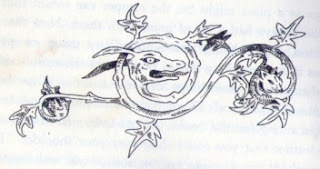
As I often do, I'm adding a few more personal comments that I didn't include in my GoodReads review. They are not spoilers exactly, but will make more sense if you've read the book.
One thing I liked about Inkheart is that it's set in the real world. It's not set entirely in an imaginary realm far away. In that sense it is like the books of Charles Williams or Alan Garner. Most of the fiction books that I have tried to write have been in such a situation, and perhaps that is why I liked this one so much.
But unlike many children's books of this type, Meggie is alone. She is an only child, but not only has she no siblings, but no friends of her own age. At one point in the story she does play briefly with some children who are younger than her, but forms no real relationships with them. Most of her interactions are with adults -- members of her family, or their friends or enemies. This is not necessarily a bad thing, but it does make her interactions with other people somewhat different.
October 13, 2021
Unholy doings on hallowed ground
 December by Phil Rickman
December by Phil RickmanMy rating: 4 of 5 stars
Four members of a rock band called "The Philosophers Stone" split up after a recording session on a December night at Ystrad Duu Abbey in South Wales. It happened to be the night that John Lennon was killed, and one member of the band felt that he was experiencing the event as it was happening. The others all experienced bad things too, so they destroyed the tapes and left without completing the album they were recording.
Fourteen years later a producer tries to persuade them to get back together to finish the uncompleted album. but they have heard that bad things had happened there before, and seemed to happen at seven-year intervals, so they are reluctant to do so, unless they can break the jinx on the abbey, whose history seems to have been less holy than they had thought.
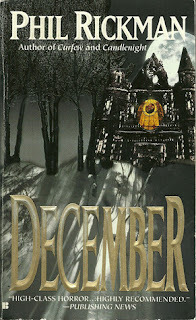
This book is vintage Phil Rickman, first published in 1994 when he was still writing horror, before he started fancying himself as a writer of whodunits, so I was glad to have found it in a second-hand bookshop, and find it was one that I hadn't read -- I've found new books by Phil Rickman in the past and then discovered that they are ones I've already read, but have been sneakily reissued by the publishers under a different title. I liked this one a lot better than some of his more recent books which are more like detective stories. In this one there are dead bodies and the police do investigate, but by the time all the bodies are counted, everyone knows who did it. It's not that I don't like whodunits. I do, and quite often read them. But there are lots of better whodunit writers out there than Phil Rickman; there are not nearly as many good horror writers.
As with most horror books there are also some pretty nasty things that happen. Why in a ruined abbey? Well, it seems that there were unholy goings on there in the past, including the ultimate betrayal. And while reading it I kept thinking of something told me many years ago by Father Ephraim of the Simonos Petros Monastery on the Holy Mountain. He said that more people go to hell from monasteries than anywhere else. It's all too easy for a monk to lose his (or her) nipsis (watchfulness).
There are some flaws. One of them was that he rapidly switches viewpoint characters without indicating which character it is, so I often found I would start reading a section, and by the third paragraph real ised which character it was, and had to go back and re-read from the beginning of the section to place the scene in my mind. That gets mildly annoying after a while.
He also included too many cliffhangers --something bad happens to one character, and just at the critical point he switches to another, and by the time you get back to the scene you find that something else had happened, and often to a different character. This is OK the first couple of times, but when it is overdone it gets tiresome, and Phil Rickman doesn't seem to know when to stop.
But aside from those rather minor niggles it was an enjoyable read.
View all my reviews
October 2, 2021
Midnight's children
 Midnight's Children by Salman Rushdie
Midnight's Children by Salman RushdieMy rating: 4 of 5 stars
A fictional autobiography of a child born at the moment India became independent in 1947.
And as the child grows up, he feels that the ups and downs of his own life mirror the fortunes of the country. Quite a long time ago I read a novel, A bend in the Ganges, set in the time of India's independence, and from that I knew it was beset by violence. That novel, like this one, followed the history of a family, and how the family was affected by the historical events. But Midnight's Children is no straightforward historical novel. It is surreal. Or perhaps paranormal. Or perhaps magic realism. It aims to show not the mere historical events, but the spiritual significance of them.
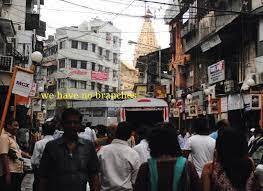
And so the children who were born at or immediately after midnight on 15 August 1947 are able to communicate with each other telepathically, and have abilities that science fiction writers of the 1950s used to indicate conventionally with the abbreviation PSI.
It is quite a dense and complex book, and I thought that, like some long and complex Russian novels, it needed a list of Dramatis Personae that one could refer to. There are so many characters that when one finds a reference to something that happened to one of them 150 pages earlier, one needs to reread the earlier incident to remember what happened and who was involved. But that means it is not the kind of book to read once and throw away. There ware things that will become clearer on a second or third, or even a seventh or eighth reading.
But now I have to take it back to the library. A few years ago I tried to read The Satanic Verses by the same author, and couldn't finish it. I found it too boring and confusing. If iot was satire, it was satirising things beyond my experience, which I couldn't connect to. But Midnight's Children reminded me of a song from 50 years ago:
Yesterday's dream didn't quite come true
We fought for our freedom and what did it do?
Now no one can see where they stand.
And fifty years ago, when we sang that song, freedom was still tomorrow's dream, but I knew, back then, that when it came and faded into the past as yesterday's dream, we would know that it didn't quite come true.
Twenty-five years ago I visited Kenya, which had been independent for just over 30 years, as India was at the end of Salman Rushdie's book. Several Kenyans asked me about South Africa, which had then enjoyed about a year of its brand-new democracy, which we had been all excited about, but the Kenyans showed no interest in that. Their questions showed that what interested them most about South Africa was the Mandela divorce, and who would get the money. They could not conceive of a politician who was not in it purely for the money. And 25 years later we have reached the same point in South Africa. And Salman Rushdie shows the spiritual reality of that, as it played out in India.
September 25, 2021
The Lathe of Heaven and the Mandela Effect
 The Lathe of Heaven by Ursula K. Le Guin
The Lathe of Heaven by Ursula K. Le GuinMy rating: 4 of 5 stars
I read this book 35 years ago, and could not remember much of it, so when I saw a GoodReads friend was rereading it, I decided to reread it too, and compare our reviews when done.
George Orr, a draughtsman in Portland, Oregon, has disturbing dreams which he believes change reality. In an effort to stop dreaming he takes drugs, which get him into trouble with the police. Have psychiatric treatment or go to jail is the choice he is offered. The psychiatrist, Dr Brian Haber, after ascertaining that George Orr is not deluded, and his dreams really do change reality, tries to use them to change the world and improve it by suggesting to George Orr what he should dream about.
Instead of being freed from his dreams, George Orr finds that he is being manipulated by Dr Haber, and with each dream, and each change of the world and its history that comes about, Dr Haber becomes more powerful and influential, until Portland becomes the capital of the world, with Brian Haber controlling much of it from his office. With each change of the world, Haber claims the credit for any improvements, but blames Orr for any defects, saying that Orr had failed to carry out his instructions in hypnotic suggestions before dreaming.
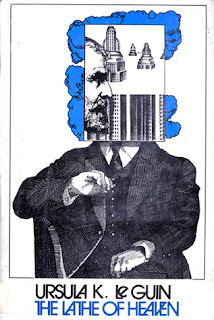
In each changed state, some people who were alive in one of the former states end up dead, or it is as if they had never been born. Only Orr. Haber, and a lawyer Orr consults (and falls in love with) realise what is happening. But their relationship is not smooth. A lunch appointment made in one world is broken in the next, as the restaurant is no longer there.
Though it is a short book, only 156 pages in the edition I read, I found it rather slow-paced in places, and thought that perhaps it would have been better as a short story. I would have given it three stars, and probably would have taken a lot longer reading it, a chapter a day at bedtime, but for some strange incidents that made me feel as though I were in a similar story, and that it wasn't just happening in a book.
The first time I read it was in rather weird circumstances too. I bought it to read on a flight from Singapore to Johannesburg, but the journey entailed waiting nearly 24 hours for a connecting flight in Colombo, Sri Lanka. I was jetlagged and bombed out and had the weird feeling of being in three time zones at once. I wrote in my diary at the time:
I took a taxi and arrived at the Orient Pearl Hotel at Katunayake at 3:00 am. It would have been 6:30 in Singapore. I went to bed, though it was a strange time to do so, and woke up at 6:30 am. It was hard to think that it was 9:00 am in Singapore and 3:00 am at home, and I seemed to be in three times at once. I read one of the books I had bought, The lathe of heaven by Ursula le Guin, which added to the weirdness. It is a kind of Buddhist book, about a guy whose dreams come true, and so every time he dreams, he changes the world, and only he can remember what the world was like before. And reading a Buddhist book in a Buddhist country in a room with drawn curtains while it is daylight outside is somewhat strange, to say the least, like the limbo of the wood between the worlds in The magician's nephew. One doesn't know which one is real.
On my second reading, the circumstances were even weirder. As I mentioned in the post before this one, on The Origin and Meaning of Heritage Day, someone on Facebook said that they thought it was previously known as "Shaka's Day", and I said no, as I remember it, it was previously known as Settler's Day.
I wanted to cite something to show that it was so, but when I did a web search the references said it was Shaka Day. So either my memory was faulty, or, as in The lathe of heaven, the world had changed, and I was the only one who remembered what it was like before the change.
But in the book. originally written in 1971, though the story is set in the period 1998-2002, the protagonist comes to terms with what is happening to himself and the world by means of the Beatles song, I get by with a little help from my friends. So I appealed for a little help from my friends. Could they remember a public holiday called Settlers Day? Very few responded, but those who did seemed to have memories as vague as mine.
So perhaps someone really is dreaming this world. and a few of us have vague memories of the previous dream. Or perhaps it is related to a similar phenomenon called the Mandela Effect, in which many people recall reading newspaper reports that President Nelson Mandela had died in prison in the 1980s.
One other observation -- in science-fiction books published a long time ago, and envisaging the world of the future, it is interesting to see what the authors foresee in the way of developments of science and technology, and society, culture and politics. In this book, first published 50 years ago, several different possible future worlds are presented, according to the different dreams of George Orr. In each one, for example, Portland has a different public transport system, different nations are at war or at peace, and space aliens have or have not visited earth. But one thing is constant -- Mount St Helen's did not erupt.
But it did erupt in 1980, didn't it? Surely I'm not the only one who remembers reading about that?
The origin and meaning of Heritage Day
The 24th of September is a public holiday in South Africa, called Heritage Day, and I've been seeing some weird stuff on social media about how it originated and what it means.
One person thought it was originally called Shaka Day, and then became Heritage Day. Several people commented, suggesting other origins, but none hit on the real one -- it was previously called Settlers Day.
Someone else posted a poll on Twitter on "What word(s) best describe what you mean by ‘heritage’?"
47,5% said "My richly diverse origins"31.9% said "My unique culture" 16.5% said "Shared African values"4.1% said "Race/ethnicity"One could argue that the first two are roughly the same -- my unique culture is, after all, the result of my richly diverse origins, which are unique to me, and what make my culture unique.
We spent most of Heritage Day this year traipsing around to three different cemeteries to unveil the gravestones of four different members of one of our church families, which seemed an appropriate thing to do on Heritage Day. And when my wife and I were both working we often spent Heritage Day on doing family history.
But, as I recall, before 1994 it was called Settlers Day, and had its origin in the republican referendum of 1960 and its aftermath. Back in 1960 a referendum held on whether South Africa should become a republic, and a majority of white voters agreed that it should (1960 was also the year in which the last black voters in South Africa lost their right to vote). So on the 31st May 1961 Queen Elizabeth ceased to be the head of state and was replaced by President Charles Robberts Swart, and the white supremacist Republic of South Africa came into being.
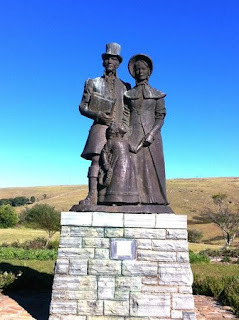 The Boere, having got their long-desired Republic at last, were feeling magnanimous to the Engelse, and since the Boere had three public holidays in the year -- Van Riebeeck's Day (6 April), Kruger Day (10 October) and the Day of the Vow (16 December) decided to give the Engelse one as well -- Ag Shame, they had lost their Queen. So they settled on Settlers Day, and I think it was first celebrated to mark the inauguration of the 1820 Settlers Monument in Grahamstown (now known as Makhando).
The Boere, having got their long-desired Republic at last, were feeling magnanimous to the Engelse, and since the Boere had three public holidays in the year -- Van Riebeeck's Day (6 April), Kruger Day (10 October) and the Day of the Vow (16 December) decided to give the Engelse one as well -- Ag Shame, they had lost their Queen. So they settled on Settlers Day, and I think it was first celebrated to mark the inauguration of the 1820 Settlers Monument in Grahamstown (now known as Makhando).President C.R. Swart, wearing a top hat and orange white and blue sash, arrived in state to officially open the monument, but I heard that Rhodes University students got in first, procured an open car, and a student dressed in top coat and sash drove along the presidential route taking the salute from all the military brass who lined it. Students also celebrated the inauguration of the monument with the Verwoerd March, which is better seen than described. The marchers line up in two columns, and the sergeant-major barks the commands:
Linker voet soos 'n kreupel beenLinker hand soos ;n DraculaBors soos ;n tortel-duif Verwooooooerd marchJuk! Skei! Juk! Skei! Juk! Skei!After South Africa became a democratic non-racial republic in 1994, such sectional ethnic commemorations were felt to be inappropriate, and Settlers Day became Heritage Day, when everyone could commemorate their heritage, whatever it happened to be. There was also a suggestion from the Inkatha Freedom Party that Settlers Day should become Shaka Day, but that was rejected in favour of something more inclusive..
That is what I recollect, as written oral history. It is what I can recall before checking any written sources.
Of course you can do a web search to find the "real" story, though it is probably less colourful, but I just wonder if anyone else has recollections similar to mine, especially anyone who was a student at Rhodes University in 1960/61.
But you if you do a web search can see
the official story herean urban legend origin story hereand a Wikipedia version of the urban legend hereAnd my conclusion is, I think my oral history is more accurate.
September 8, 2021
The Deeping Secrets

The Deeping Secrets by Victor Watson
My rating: 5 of 5 stars
Five children on a war-time spy hunt.
Serendipity is pulling a book at random off the library shelf and finding that it is a really enjoyable read -- "unputdownable", as the hack reviewers like to say to get their reviews quoted in the blurb. In this case, I saw the word "Deeping" in the title, wondered what it was about, read the blurb, and then found it hard to put down until I had finished the book.
It seems that when you mention stories of kids having adventures what comes to most people's minds is the Famous Five by Enid Blyton. Well this one could not be the Infamous Five, but possibly the Obscure Five. Five kids start their school holidays in the middle of a wartime spy scare, and exciting adventures follow.
It actually made me think less of the Famous Five (which I didn't read much as a kid anyway) than of the "William" books of Richmal Crompton. Those were a series of short stories with the same characters rather than novels, but they did take place in war time, and William did occasionally take part in spy hunts, though William's chief suspect would usually turn out to be quite innocent in a case of mistaken identity.
In The Deeping Secrets five children, Molly, Abigail, Joe, Edward and Adam, are rather fed up with the war, which spoils their school holidays with blackout regulations, rationing and the like, but then are faced with a spy and would-be saboteur.
I read the "William" books when i was about 10, and found myself almost wishing that it could be war time -- with all the excitement in life caused by suspected spies and fifth-columnists and quislings. And I learnt such terms from those books. But when I tried, nostalgically, to re-read the "William" books as an adult, I was impressed with two things: (1) the vocabulary was pretty sophisticated for children the same age as the child characters in the books, and (2), the child characters in the books were seen through adult eyes -- they did the things that adults find amusing when kids do them, and so they were condescending in the bad sense, laughing at the things that children did rather than at the things that children find amusing.
The Deeping Secrets does not have these faults. It really is a children's book, written from the point of view of children. And in style, characters and plot it is way ahead of the Famous Five books, whose fame, it seems to me, is quite undeserved. The point of these comparisons is that the fame of some well-known children's adventure stories is largely undeserved, and this one is one of those that deserves to be better known.
Another thing that I found interesting about the book was that it is set in the year that I was born, and the denouement came two days before I was born, on Good Friday 1941. And that got me wondering about the genre of historical novels. At what point does a novel become historical? I've written children's books that are set in a period 23 years later, in 1964 (you can see them in the side-bar on the right), which would make them ancient history to any children who read them today, but for me is within living memory. So could one define a historical novel as something written about a period before the author was born, or before anyone now living was born, or as something else?
View all my reviews
September 6, 2021
The Mission: A Life for Freedom in South Africa, by Denis Goldberg
 The Mission: A Life for Freedom in South Africa by Denis Goldberg
The Mission: A Life for Freedom in South Africa by Denis GoldbergMy rating: 4 of 5 stars
A very readable autobiography of a South African political activist.
Denis Goldberg was born and grew up in Cape Town. His parents were communists, and imparted to their children a desire for social justice. He went to university and studied engineering, and became a civil engineer. In the 1950s he joined the Congress of Democrats which was part of the Congress Alliance of organisations opposed to apartheid, with separate organisations for black, white, coloured and Indian South Africans. The Communist Party had been non-racial, but when the National Party came to power in 1948 one of their first acts was to ban the Communist Party of South Africa, which then went underground as the South African Communist Party.
The Congress Alliance sponsored the Congress of the People in 1955, which in turn adopted the Freedom Charter, which put forward the vision of a democratic non-racial South Africa. But those the National Party government regarded as the organisers were arrested and charged with treason, though after four years they were all acquitted.
In 1960 all the parties in the Congress Alliance were banned and they too went underground, and decided that, since peaceful protest no longer seemed a workable political activity, they should move to armed struggle. Denis Goldberg was among those arrested and tried in the Rivonia Trial of 1962, and was sentenced to life imprisonment, though he was released after 22 years. He describes the events leading up to his arrest, the trial, and his time in prison.
After he was released he went overseas and joined his wife Esme in the UK, where he worked to publicise the African National Congress (ANC) and its cause in Britain, Europe and elsewhere. After the ANC was unbanned in 1990 he worked to gain support for community development projects in South Africa. When his wife Esme died he married again and returned to South Africa, where he used his engineering training to advise successive ministers of Water Affairs and Forestry.
The parts of the book describing his personal and family life and his time in prison are very clear and readable, but his descriptions of the political situation and political activities are less so. These parts of the book could be confusing to readers who do not have prior knowledge of the political history of the times. In some places, when describing the political scene of the 1950s, he mentions the Non-European Unity Movement, but seems to assume that his readers will know that it was, what its policies were, and how it differed from the Congress movement.
In other parts, he gives the impression that he is writing an apology to defend himself from criticisms by his colleagues in the ANC. This is no doubt because he was criticised in some quarters, but exactly for what is only hinted at and not stated explicitly. In these parts of the story one gets the impression that he is writing for his colleagues to defend his own actions, and not for the general reader.
I do not agree with all his views, and there were some attitudes that seemed alien to me. As a pacifist, I was never too taken with the idea of the armed struggle and the use of violence, though I recognise that not everyone is a pacifist and most people are unlikely to be. And as a liberal I felt a bit uncomfortable with the top-down authoritarian structure. Of course that was partly because they saw themselves as an army, and so developed along military lines with a top-down command structure. Nevertheless, the need for getting approval for everything from the next level of command in the rather rigid hierarchy seemed strange to me, especially when the movement was underground. I would have expected more flexibility, and expecting members to do things on their own initiative rather than passing everything up the command chain and waiting for permission to come back down.
It would make more sense to me to ensure that people are familiar with the general principles and policies of the organisation, and apply them in ways that are possible in particular circumstances of time and place. But Goldberg writes in such a way as to give the impression that he is trying hard to preclude or counter accusations that he was acting on his own initiative.
Later, however, when the ANC was in power, he accuses civil servants of being dull and unimaginative and obstructive of changes that would better the life of the people. I think his criticisms are justified, but it might be the authoritarian structure of the ANC that has caused it.
View all my reviews
September 5, 2021
King Arthur, Arthurian literature and the Holy Grail

King Arthur In Legend And History by Richard Barber
My rating: 4 of 5 stars
This is the second book on Arthurian literature I've read in the last month, and since I read them so close together, I can't help comparing them. The first one was King Arthur: the True Story, and you can see my review here.
This book is the earlier one (first published in 1961) and in my opinion the better one, though it gets a lower rating on GoodReads, perhaps because of the limitations of the 5-star rating system. In a 10-star system I would give King Arthur in Legend and History 7 stars, and King Arthur: the True Story only 6.
The books start at opposite ends of the story, and work in different directions.
King Arthur in Legend and History starts with what is known of the historical Arthur, and then follows the development of the legend in literature. King Arthur: the True Story starts with the developed legend, and works back towards the history. That is because its main purpose is to present its candidate for the true historical Arthur, and so, apart from a general survey of the literature at the beginning, its main argument is directed to that end.
Richard Barber, on the other hand, shows how scanty historical sources led to the growth of a rich literary legend. On the whole, I liked his book and his approach better. He also deals much more thoroughly with the later Arthurian literature, which is of little interest to anyone looking for clues to the historical Arthur. He also gives quite a bit of space to one of my favourite authors, Charles Williams, though he concentrates on his poetry, and not on his prose narratives.
Barber compares most of the major Arthurian writers, and compares the way in which they presented the stories and the characters, and also how people in different periods tended to present them differently.
I'm almost more interested in the history of the literary treatment of the legend than I am in the legend itself. For one thing, King Arthur himself seems to play very little part in the stories. Other than at the beginning, where he becomes king, and the end, with his rather enigmatic end, he seems to do little except announce that he will fast until one of his knights has an adventure and comes back to tell him about it. And the rest is the story of the adventure of this or that knight -- adventures that often seem to involve murder or adultery or both.
One of the things I find most interesting, though, is the story of the Holy Grail, or Graal. This was introduced to the Arthurian story by Crétiene de Troyes about 1190, though he does not describe it in detail. Within ten to fifteen years (about 1200-1210) Robert de Boron had expanded this narrative, and the Graal had become the cup used by Christ at the last supper. brought to Britain by Joseph of Arimathea and taken to Avalon by Bron the Rich Fisher.
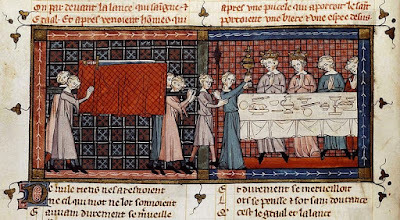
I don't think that it is mere coincidence that this was the very period in which the word "transubstantiation" was introduced into Western theology to explain the transformation of the Eucharistic elements of bread and wine into the body and blood of Christ. It was in 1215 that the Lateran Council declared that the doctrine of Transubstantiation was essential to the faith. For more details on this see Eucharistic theology and witchcraft.
Though Barber discusses Charles Williams's Arthurian poetry, he does not mention his novel on the Graal, War in Heaven, which also introduces the figure of Prester John. It is a kind of 20th-century version of a Grail Quest, with the Duke of North Ridings playing the part of a questing knight, with his Roman Catholic Eucharistic theology, and the Anglican Archdeacon of Fardles having a somewhat more mystically real eucharistic theology.
Now perhaps there is somewhere, mouldering on a forgotten shelf in some university library, someone's doctoral thesis on the parallels between the development of Western Eucharistic Theology in the late 12th and early 13th centuries and the development in the legend of the Grail in Arthurian literature during the same period, and if so, I'd like to read it. But if there isn't one, I would love to see someone working on one, and someone suggesting that to potential students as a possible topic.
September 4, 2021
Zionist origins in South Africa
The Daily Maverick recently published an interesting article about Wakkerstroom, the birthplace of Zionist Christianity in South Africa -- if you are not sure about the difference between Zionist Christianity and Christian Zionism, see here.
The Daily Maverick article, with the title Letter from Mpumalanga: Listening to history’s whispers by the river of enlightenment, has some interesting pictures of the places where Zionist Christianity started in South Africa at the turn of the 20th century. It has since split into numerous different denominations, the largest of which, the Zion Christian Church, is the biggest single denomination in the country.
Around 1900, a Dutch Reformed missionary living in Wakkerstroom, Pieter Le Roux, became interested in the Christian Catholic Apostolic Church in Zion, Illinois. Zion was a utopian community dedicated to two chief propositions, both radical in their time: one, that doctors were unnecessary because Jesus could heal all ailments; and two, that all races were equal in the eyes of God.Both propositions resonated with Le Roux, who spoke fluent Zulu and seems to have had unusually egalitarian ease with black Africans in that era. Le Roux tried to resign from the Dutch Reformed church, but they asked him to delay his departure until after the Anglo-Boer war.
The article is misleading in some respects -- first, while the church in Wakkerstroom was the first Zionist church in South Africa, it was not the first African independent church (AIC). There were several earlier AICs, such as the Ethiopian Church which started in Marabastad, Pretoria, about ten years earlier, and a movement started by Nehmiah Tile even earlier than that in the Eastern Cape. Secondly, the early history of Zionism has been fairly well documented in numerous books, including some by my erstwhile colleague Allan Anderson -- see, for example: Zion and Pentecost,
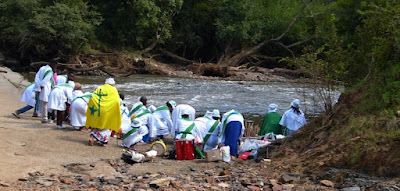
What is significant in this article, though, is the description of the physical sites of early Zionist history, which should surely be declared historical monuments, and the Daily Maverick article is illustrated with some interesting photos of these.
There is also something that puzzles me, and I hope someone familiar with the sources of early Zionist history will be able to enlighten me. This article, and most of the books I have read on the topic, say that the first Zionists were baptised in the river that runs through Wakkerstroom -- the eponymous wakker stroom (wakeful or lively stream). But some mention the Slang River, which is over the mountains, and indeed, in those early days over the border in a different country, the then Natal Colony. The photo in the article clearly shows the same bridge in Wakkerstroom as appears in the old photo, So I wonder about the source of the mention of the Slang River, as something in the early history of Zionism that needs to be clarified. Did Le Roux and his flock flee across the mountains to Natal at some point -- and if so when, and for what reason? I am curious, partly because I was at one time quite familiar with Groenvlei in the Slang River valley and I used to visit the Anglican church there once a month for services, but that's another story, which you can read about here, if you are curious.
Anyway, I was pleased to see this article, and to see that some are beginning to take an interest in preserving the history of one of the most significant movements in South African Church history, and from which the largest group of Christians in South Africa spring.
August 20, 2021
King Arthur: the True Story

King Arthur: The True Story by Graham Phillips
My rating: 4 of 5 stars
King Arthur is a well-known figure in European romantic literature, but the historical character he is based on is vague and elusive. The authors of this book believe they have identified him as Owain Ddanngwyn, ruler of Powys in west-central Britain from about AD 488-520. "Arthur", they say, was not his actual name, but an epithet or nom de guerre meaning "The Bear", being a combination of the Brythonic "arth" and the Latin "ursus", both of which mean "bear".
I am in no position to evaluate the accuracy of their claims, because I am not sufficiently versed in the history of that period, which many historians have referred to as "the Dark Ages" because so little written history has survived from then, and so historians of the period are left feeling their way in the dark. It is like trying, in 2021, to find the biography of a ruler in southern Africa around 1390. There are no contemporary written sources, so that for us is the southern African "Dark Ages".
I came to read this book in a strange way. I went to the library to renew some books I hadn't finished reading, and saw this one lying on a table. Someone had taken it off the shelf, decided not to take it out, and left it lying there for a librarian to reshelve. I wasn't looking for it, nor would I probably have found it if I had been, but it just appeared in front of me, as if it were saying "Read Me".
What I can say of the book by way of evaluation is that it starts off with a good summary of the Arthurian literature, and how the legends of Arthur were popularised (and in many instances created) in the 12th century by Geoffrey of Monmouth and subsequent writers. So I found the first few chapters very good as an account of how the Arthurian legend developed, and its early sources.
The further one goes into the book, however the more tenuous and speculative the story becomes, and the less convincing becomes the sub-title, "The True Story". The authors don't pretend otherwise. Their prose in the later chapters is extremely conditional, "if x happened, then y could have followed", "It is conceivable that...".
Much of the knowledge of the period comes from archaeology, which can tell us something of what life was like in a particular period, and what kind of people lived where, but it tells us very little of the actual events that led to those conditions. Pottery fragments can tell us whether the people who lived in a place were Angles or Saxons or British, but does not tell us their names, and whether they were ruled or led by someone called Arthur.
I also have to ask myself why I should be interested in Arthur or Arthurian literature. Most of the literature was written 600 years later, and tells us more about that period than about the time when Arthur lived, if he ever did live. One of the things that interests me about it is the intersection of history, myth, legend and theology, some aspects of which I have dealt with in an earlier blog post -- see South African Camelot.
View all my reviews



